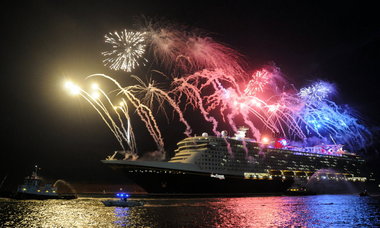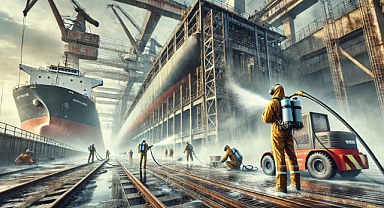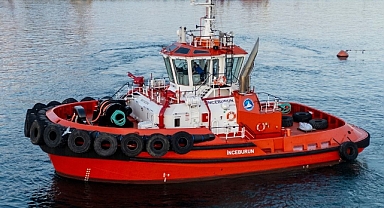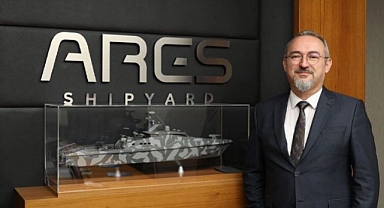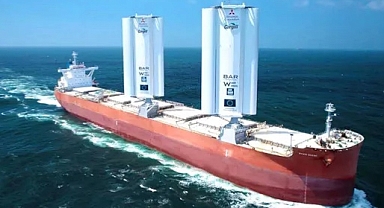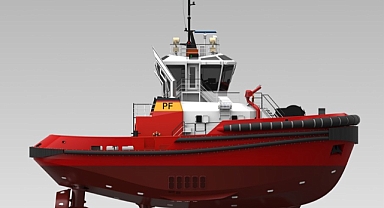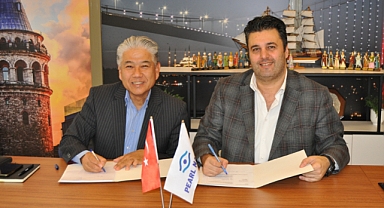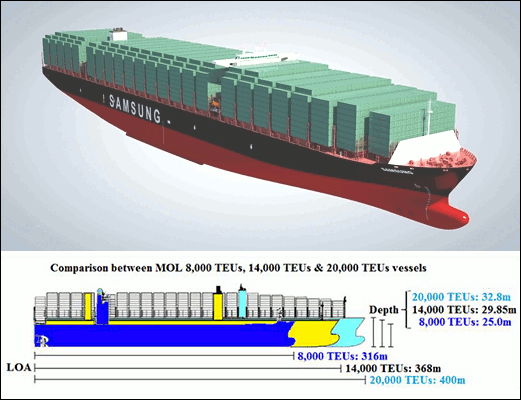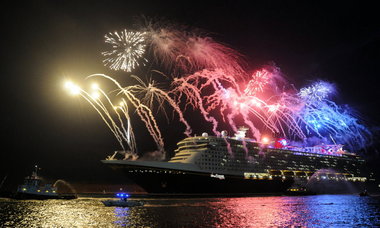 (Michael R. Brown, Florida Today) Fireworks light up the sky this month as the new Disney Dream arrives in Port Canaveral, Fla. The ship, Disney’s first in more than 10 years, starts Caribbean sailings in late January.The greatest cruise-ship building boom in history -- fueled by innovation and new technology -- is not over, but it is winding down.
(Michael R. Brown, Florida Today) Fireworks light up the sky this month as the new Disney Dream arrives in Port Canaveral, Fla. The ship, Disney’s first in more than 10 years, starts Caribbean sailings in late January.The greatest cruise-ship building boom in history -- fueled by innovation and new technology -- is not over, but it is winding down.
While some ships still are on order or under construction, the future soon will be nothing like the recent past, when fleets of cruise ships with new styles and exciting new designs popped out of European shipyards at a furious pace.
Following this winter season's Queen Elizabeth from Cunard, Royal Caribbean's Allure of the Seas, Oceania's Marina and the Disney Dream, passengers are looking largely at sister ships for the next few years from Carnival, Seabourn, Celebrity, Costa, MSC, Oceania and Disney. One big player, Norwegian, has two 4,000-passenger ships on order for 2013 and 2014 that are expected to follow the basic design of a current ship, the Norwegian Gem. Royal Caribbean has nothing on the future burner at the moment.
Looking back, the last decade has been one of innovation, from balcony cabins and a host of fancy restaurants to ice skating rinks and circus performers, from ships within a ship to studio cabins and a living room for singles. Chances are, we will never again see the likes of the innovations aboard the gigantic Oasis of the Seas and Allure of the Seas -- big enough to take a small town on an ocean holiday -- or the curved cabin walls and peculiar potty plans of the edgy Norwegian Epic. Norwegian has said its next ships will not have the same design as Epic.
Cruise lines say they didn't really tear up the old blueprints for ships and start anew in the past decade, but they did think outside the usual boundaries. Designs evolved with emphasis on profitability, maritime laws -- mostly aimed at the environment -- and heavy competition for passengers, old and new, who have more vacation choices on land and at sea than ever before.
Where innovation meets tradition
When deciding between traditional design and innovation, each cruise line has its own brand to consider, said Ruben Rodriguez, executive vice president of ship operation and product development for Carnival Cruise Line.
"We have paid more attention in the last few years to the designs that are visible to the guests, as the consumer has become more sophisticated," he said.
One Carnival example, Rodriguez said, is Serenity, a quiet oasis outside for adults. The concept was incorporated into the design on Carnival Splendor after being introduced on two existing ships.
The Serenity oasis was expanded for Carnival Dream in 2009.
"Carnival would have rejected the Serenity concept 15 years ago," said Rodriguez, "but now we are attracting people who want a quieter area. Their idea of fun is reading and relaxing."
The other major design change for passengers at Carnival is to open its new ships to the outdoors, particularly on its promenade deck, connecting the Ocean Plaza indoors to an outside lanai. That's a huge transformation from Carnival ships that once were characterized as big boxes with a pool on top. Most of the action on the older Carnival ships was indoors.
Profitability is a major factor in ship design. With aggressive price competition among cruise lines, companies are building ever-larger ships to add more cabins and to give them room to add more revenue-producing features such as bars, a bigger spa, restaurants with a fee, and more exclusive cabins where the rates are substantially higher.
Norwegian is a leader in offering more restaurant and eating choices for passengers, which other cruise lines have followed, requiring design changes in main dining rooms. Those have grown smaller as alternative restaurants have been added. Celebrity, meanwhile, is a leader in establishing an interior contemporary design in its style, artwork and menus. The line, which offers restaurant-quality, fine dining on its new, large Solstice Class ships, introduced an iPad menu in the trendy Qsine restaurant on the Eclipse.
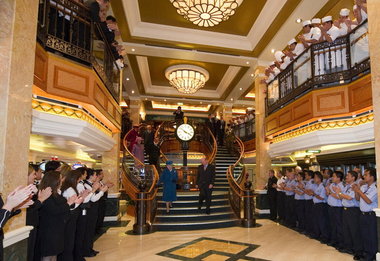 (Arthur Edwards, Associated Press) Britain's Queen Elizabeth II, descending the stairs, was on hand in October for the naming ceremony of Cunard’s new ship, the Queen Elizabeth. Now on an around-the-world cruise, it sails from England in the spring.Design makes ships alluring
(Arthur Edwards, Associated Press) Britain's Queen Elizabeth II, descending the stairs, was on hand in October for the naming ceremony of Cunard’s new ship, the Queen Elizabeth. Now on an around-the-world cruise, it sails from England in the spring.Design makes ships alluring
For design, this is turning out to be a rewarding winter season.
A new Queen Elizabeth is always exciting. The third Queen Elizabeth began cruising in October. Cunard has produced decor that aims for traditional ocean-liner style -- grand public rooms with high ceilings, rich wood paneling, mosaics, marble, chandeliers, and Art Deco features from the original Queen Elizabeth.
Royal Caribbean's new Allure of the Seas may not have the same wow factor as the 2009 debut of Oasis of the Seas -- the first ship with a zip line, an outdoor AquaTheater with a diving platform 72 feet high and an array of restaurants and bars that includes one watering hole that rises and falls two decks in about the time it takes to drink half a beer. But the Allure has its own allure, with new restaurants, a new Broadway show ("Chicago: The Musical"), new shops and characters from DreamWorks.
Disney, one of the great innovators, waited a decade to introduce a new ship, the Disney Dream, debuting later this month.
Other cruise lines build fancy water slides. Disney has introduced a high-speed flume ride that goes up and down, with twists, turns, drops, acceleration and river rapids. The AquaDuck water coaster, at 765 feet long, spans four decks and swings out 13 feet over the side of the ship in a translucent tube 150 feet above the ocean. Inside, Disney Dream features enchanted pictures on the walls -- some interact with passengers -- and interior cabins with an active porthole view of the ocean and an occasional visit by a starfish from "Finding Nemo." An animated Mickey Mouse may visit your cabin while you get ready for dinner.
"All the designs were created from scratch with various interior designers from around the world," said Michael Davie of Walt Disney Imagineering.
Standout design on smaller ships
Some of the biggest changes in design are on smaller, more luxurious vessels, which are bigger than luxury ships used to be, because most cruise lines have decided they need about 450 to 500 passengers to keep prices from skyrocketing above what even wealthy vacationers are willing to pay.
Seabourn, for instance, is on a building spree, adding the 450-passenger Odyssey, Sojourn and Quest to its three earlier luxury vessels that were one-third the size with about half the passengers. Seabourn is trying to balance the traditional yachtlike feel with a desire to attract younger passengers by adding deck space and restaurant choices and enlarging the spa. It seems to be working, as Seabourn is attracting a younger, more energetic crowd, reviewers say.
Worth watching is Oceania's new ship, the Marina, which arrives in South Florida in early February. Oceania hopes that the 1,250-passenger vessel will appeal to vacationers willing to pay as much as $400 per person per day for luxurious surroundings, a price that is higher than some of its competitors but below the rate for the most luxurious ships.
Marina will stand out because of its rich residential furnishings from top-notch designers, said Tim Rubacky, senior director of corporate communications for Oceania and Regent Seven Seas.
"Some 90 percent of cruise ships look like you're walking onto a floating Hyatt," said Rubacky. "Seabourn, for instance, is probably the finest luxury product out there, but it's designed with institutional furnishings. It's like a luxury hotel. Our staterooms have more of a luxury bedroom feel than a hotel feel, with no off-the-rack furnishings." The three owner's suites on Marina were designed by Ralph Lauren Home. A grand stairway for the ship's reception area was designed by Lalique, French artists of jewelry and crystal.
Two other new small ships with innovative design are Le Boreal, a French vessel that has been chartered by Abercrombie & Kent for trips to Antarctica, and the Avalon Panorama, the first European river ship with suites, 64 of them.
Le Boreal debuted last year. The 264-passenger vessel has less of a cruise-ship feel, said Bob Simpson, A&K's vice president of business development. Inside, it's more like a boutique hotel, he said, with a state-of-the-art lecture theater. Outside, it's built as an expedition ship. Le Boreal carries only 199 passengers -- some in two-room suites -- when chartered by A&K for Antarctica.
The Avalon Panorama will begin cruising in May. It is one of a series of new Avalon river vessels.
Cruise lines have to be clever when designing new ships for European rivers, said Melanie Gravdal of Avalon. Because space is so tight in river locks and under bridges, new ships can't get bigger than the old ships. So, Avalon has rearranged the space to make roomier cabins and to bring the outdoors in by adding big picture windows and French balconies. Suites on Avalon Panorama will be 200 square feet, at least 50 square feet more than typical river cruise cabins.
Design changes below deck
Behind the scenes, and under the lowest passenger deck, huge design changes have followed new laws, new sensitivities about the environment, and competition for hiring and retaining crew to meet the needs of more and bigger ships.
These include fuel-efficient engines, better propulsion systems, cleaner wastewater treatment, less smokestack emissions, and better working and living conditions for crew.
Wastewater treatment aboard ships involves some of the most sophisticated equipment anywhere in the world, say cruise-line engineers.
"The most positive design impact we can have is reducing our fuel consumption," said Carnival's Ruben Rodriguez. "We reduce it every year through changing itineraries, ship speed and new technologies. The impact is on reduced emissions and the cost of fuel."






